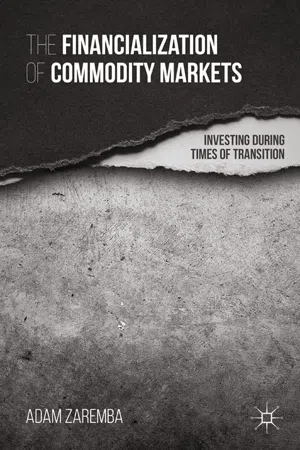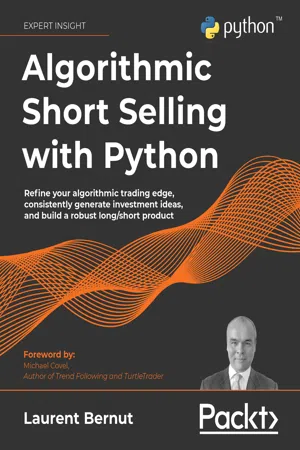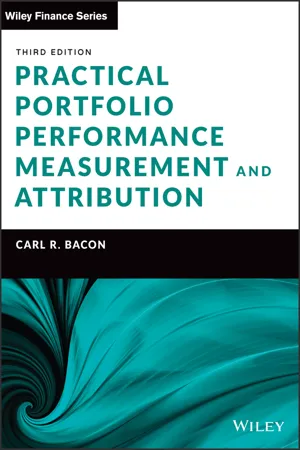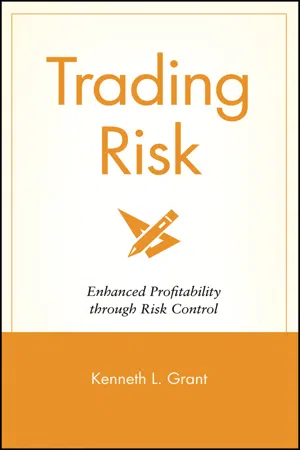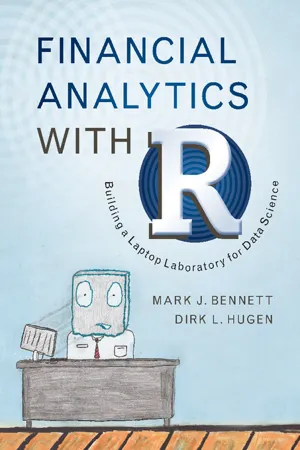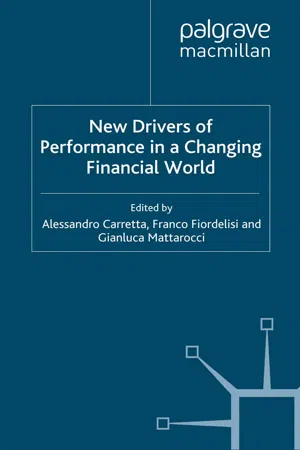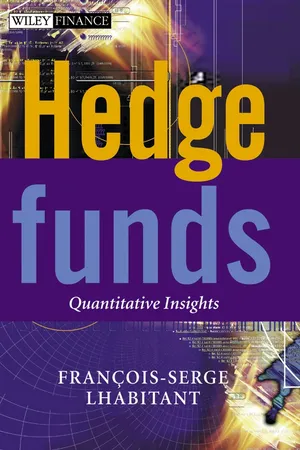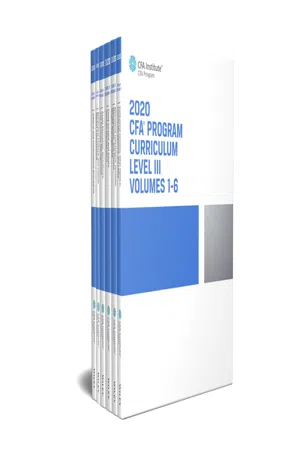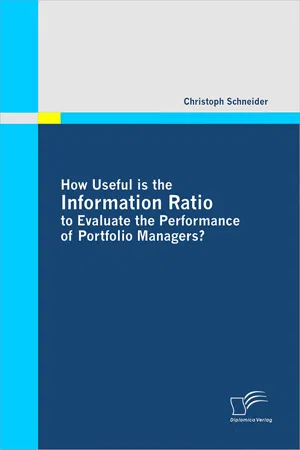Business
Sharpe Ratio
The Sharpe Ratio is a measure of risk-adjusted return, commonly used to evaluate the performance of an investment or portfolio. It calculates the excess return generated per unit of risk, with a higher ratio indicating better risk-adjusted performance. By considering both return and volatility, the Sharpe Ratio provides a valuable tool for comparing investment opportunities and assessing their risk-return tradeoff.
Written by Perlego with AI-assistance
Related key terms
1 of 5
10 Key excerpts on "Sharpe Ratio"
- eBook - ePub
The Financialization of Commodity Markets
Investing During Times of Transition
- A. Zaremba, Kenneth A. Loparo, Iver B. Neumann(Authors)
- 2015(Publication Date)
- Palgrave Macmillan(Publisher)
Then, the most important drawbacks of the described measures, which are most visible in the context of the subject being studied, are listed. Ultimately, the two new measures that are aimed at correcting the shortcomings of their predecessors are discussed. These measures are later used in the empirical study presented in chapter 6. 1 Sharpe Ratio William Sharpe, later a Nobel Prize winner, published a paper titled “Mutual Fund Performance” in 1966, in which he described an index that was later named after its creator. The Sharpe Ratio is still, without a doubt, the most popular investment performance measurement tool, which takes into account not only the profit, but also the risk. Traditional Definition In the most traditional approach, the Sharpe Ratio measures the excess rate of return per unit of risk taken by the investor (Sharpe 1966). The Sharpe Ratio is calculated by dividing the excess return and risk, understood as the volatility (standard deviation) 2 of rates of return, which is reflected in equation (12). where R p represents rate of return on the portfolio being evaluated during the relevant period, R F represents rate of return on a risk-free instrument, and σ p represents volatility of portfolio returns. All values are customarily given per annum. It is extremely important that the level of the Sharpe Ratio is dependent on the length of the analyzed period (time dependent). This is because, as the analyzed period gets longer, the expected rates of return grow linearly or exponentially and the standard deviation increases approximately in proportion to the square root of the period concerned (Lhabitant 2008b, p. 455) - eBook - ePub
Algorithmic Short Selling with Python
Refine your algorithmic trading edge, consistently generate investment ideas, and build a robust long/short product
- Laurent Bernut(Author)
- 2021(Publication Date)
- Packt Publishing(Publisher)
The Sharpe Ratio is such an intricate part of life in the industry that a mundane greeting such as "how are you?" could easily be interchanged with "how is your Sharpe?" The question the ratio is trying to answer is conceptually simple: for every unit of volatility, how many units of excess returns over a risk-free asset do you receive in return? Now, all the problems derive not from the formula, but from the meaning people have ascribed to volatility. Is volatility bad, risky, or uncertain?Here is the mathematical formula of the Sharpe Ratio, where Rp is equal to asset returns, and Rf is equal to risk-free returns:This ratio looks at the annualized average excess returns over a risk-free asset divided by the standard deviation of those returns. Standard deviation measures the variance from the median returns. The more volatile the returns, the higher the standard deviation, and the lower the ratio (and vice versa). The excess returns over a risk-free asset is a simple test: for every additional unit of volatility, are you better off parking money with a specific manager or keeping it safe with T-bonds or money market funds?Even the genius William Sharpe has become critical of the measure he created and that has now become the default industry standard: the Sharpe Ratio. This metric served its purpose. There are two things it did really well:- Cross-asset unified measure : it is now widely accepted that the most critical component in alpha generation is asset allocation. The difficulty is to have a unified risk-adjusted measure of alpha across asset classes. This is where the Sharpe Ratio did the job. It can be calculated across fixed income, equities, commodities, and so on.
- Uncertainty : the human brain is hardwired to associate uncertainty with risk. It triggers the amygdala and activates the fight, flight, or freeze reflex.
Now, the Sharpe Ratio was invented in 1966. It was revolutionary in revolutionary times: El Che Guevara and Fidel Castro were still fighting Batista in Cuba. As the pioneer William Sharpe himself said, it was good when computing power was still limited. But since then, times have changed. Doctors have stopped prescribing cigarettes to pregnant women, plastic has become the dominant marine species, and computers more powerful than those that sent people to the moon now fit in everyone's pocket. - Carl R. Bacon(Author)
- 2023(Publication Date)
- Wiley(Publisher)
23 Sharpe, “Mutual Fund Performance” (1966). 24 Akeda, “Interpretation of Negative Sharpe Ratio” (2003). 25 See Dowd, “Adjusting for Risk: An Improved Sharpe Ratio” (1999) and Kidd, “The Sharpe Ratio and the Information Ratio” (2011). Risk 161 Interpretation Sharpe Ratios, like returns, are best used for comparison against the Sharpe Ratios of bench- marks or other portfolios rather than analysed in isolation. Roy ratio The Sharpe Ratio is regarded, quite correctly, as the grandfather of all risk-adjusted performance measures, despite the fact that the Treynor ratio predates the Sharpe by one year, and that Arthur Roy 26 suggested a similar measure as early as 1952: Roy ratio RR = r − r T (5.22) where: r T = annualised minimum target return or “disaster level” Risk-free rate The risk-free rate of return is defined as the rate of return an investor can expect from a theo- retically risk-free investment. Of course, no investments are genuinely risk free and even cash returns will display some variability. Investors’ perceptions of the risk-free rate of return will differ, ranging from short-term rates of interest to long-term interest rates or even real risk-free rates adjusted for inflation. In the context of the reward-to-risk ratios covered in this chapter the actual choice of risk-free rate is not as crucial as might be imagined. Consider a magnet attached to the risk-free rate that allows movement up and down the vertical axis – although the calculated ratio may differ with different risk-free rates, the ranking of portfolios is not significantly impacted. Caution When comparing the Sharpe Ratios of portfolios, it is important to ensure that risk-free rates are consistent. Risk-free rates will vary depending on investor preferences, typically across currencies, and as we have observed in recent years may even be negative.- eBook - PDF
Trading Risk
Enhanced Profitability through Risk Control
- Kenneth L. Grant(Author)
- 2004(Publication Date)
- Wiley(Publisher)
Most famously, and most relevantly for our purposes, these concepts are embodied in the Sharpe Ratio calculation, which you may recall is a ratio of returns to their associated volatility. If we can estimate our Sharpe Ratio with relative accuracy, we have a pretty good notion of the kind of return we can expect for a given level of performance volatility. But what if we are looking to ask the opposite ques- tion? What if instead of wondering what return we can expect, given the riskiness of our portfolio, we want to figure out how much exposure we need in order to generate the level of performance we desire? As it turns out, with a quick sleight of algebraic hand, we can manipulate the Sharpe Ratio equation to determine both what a given level of volatility will pro- duce in terms of returns and (more important for our purposes here) what level of volatility is consistent with a given performance target. In order to understand this critical concept as thoroughly as its importance demands, 112 TRADING RISK let us take the steps involved one at a time. Begin by resurrecting the basic Sharpe Ratio equation: Sharpe Ratio (Return Risk-Free Rate) Portfolio Volatility The Sharpe Ratio can be thought of as a scorecard of your perform- ance as a portfolio manager from a risk-adjusted-return perspective. It also is a measure of the amount of return you are likely to generate for a given dollar of risk, which, as argued earlier, is a concept that is expressed most succinctly in the portfolio volatility statistic. Thus, once you have carefully analyzed your Sharpe Ratio and are comfortable that the number you have calculated is one that you can sustain, you can invert this equation to determine what level of return you are likely to generate for a given level of risk assumption. - eBook - PDF
Financial Analytics with R
Building a Laptop Laboratory for Data Science
- Mark J. Bennett, Dirk L. Hugen(Authors)
- 2016(Publication Date)
- Cambridge University Press(Publisher)
Looking closely at the passer rating equation, Formula 7.1 above, it is clear that interceptions, which are mistakes, are penalized twice as much as pass completions, successes, are rewarded. This is because mistakes can be so costly to the team. Just like interceptions, the adverse market events are hard to overcome. Market drawdowns in value can ruin people’s future retirement income or even their current income, so we need to be careful about how to analytically account for this. 7.1 Sharpe Ratio Formula As a long-time standard for measuring investment efficiency, the Sharpe Ratio is impor- tant. Intuitively, the Sharp Ratio combines two important statistical moments of a random variable representing a security price time series (Sharpe, 1964). If the invest- ment is a mixture of securities in a portfolio, P, the Sharpe Ratio is the mean return over and above the risk-free rate divided by the volatility: E {R P } − μ f σ P . (7.2) We can think of the volatility as a measure of risk. For every unit of risk, we have the excess return over and above the risk-free rate provided by taking that risk. Figure 7.1 depicts high Sharpe Ratio stock prices in separate charts. These are actual daily price charts using historical data. The tickers symbols were omitted to create a sense of mystery. These might be deemed “good looking” to an investor in that they have drawdowns of short duration and continue to generally rise. We can think of these perhaps as the best quarterbacks in the NCAA, using our passer rating analogy. 7.2 Time Periods and Annualizing Often, one can read books or journal articles quoting Sharpe Ratios, and they can seem too high or too low when remembering other instances. “Let’s see, now, was that good Sharpe Ratio we talked about, 2.0 or 0.2?” It is important to recognize that it should be thought of as a unitless figure computed on a time series. The interval of the time series determines the implicit units. - A. Carretta, F. Fiordelisi, G. Mattarocci, A. Carretta, F. Fiordelisi, G. Mattarocci(Authors)
- 2008(Publication Date)
- Palgrave Macmillan(Publisher)
It is calculated as a ratio of the total gains to the total losses related to the investments in a hedge fund for the time period under examination (Keating and Shadwick, 2002). The Sharpe Omega uses the same approach as is utilized for the Sharpe Ratio, but the risk measure is estimated analysing the Omega function (Kazemi et al., 2003). The Kappa represents a modified Sortino Ratio that uses, as measure of the fund’s gains, the excess return of the fund with respect to the minimum return that is acceptable for the investor. The RAP is computed as the ratio of this difference to the lower partial moment of the return distribution (Kaplan and Knowels, 2004). The D-Ratio does not consider the moments of the returns’ distribution and classifies funds only on the basis of the frequency of losses and gains. Hedge funds’ rankings are calculated by taking into account the ratio of positive and negative performances achieved in the time period analysed (Koh et al., 2002). The ROAS and the ROPS use the same approach proposed by Sharpe for the performance measure – the mean excess return of the hedge funds’ performance on the risk-free rate – but use a different risk mea- sure: the first one uses the absolute shortfall and the second one uses the probability of losses (Koh et al., 2002). The Hurst ratio is a measure of the persistence of the time series that can be useful in evaluating the validity of a performance evaluation based on historical data. The Hurst ratio is useful in allowing an investor to dis- tinguish between the good portfolio managers and the ‘lucky’ portfolio managers (Amenc et al., 2002). The Calmar ratio and the Sterling ratio are computed using another risk measure, the potential maximum loss related to a specific invest- ment (Braga, 2001). The Calmar ratio is calculated as the ratio of mean return over the maximum drawdown and the Sterling ratio is the same measure evaluated using a smoothed maximum drawdown (Pedersen and Rudholm-Alfvin, 2003).- eBook - ePub
Hedge Funds
Quantitative Insights
- François-Serge Lhabitant(Author)
- 2009(Publication Date)
- Wiley(Publisher)
Table 4.9 shows the RoVaR of our five funds using a one-month historical value at risk calculated at 99% and at 95% confidence. Once again, the ranking differs, because the risk definitions are different.Box 4.4In the case of normally distributed returns, it is relatively easy to express the RoVaR of a portfolio as a function of the Sharpe Ratio, as the VaR typically depends on the mean return (RP ) and on the volatility of the portfolio (σP ). More precisely: where -k is the standard normal variable reflecting the confidence level on which the VaR is predicated (for example, k = -1.645 if we have a 95% confidence level). It follows that: Using equation (4.1) to replace RP , we obtain This shows that there is a link between the RoVaR and the Sharpe Ratio. It also evidences that we should not expect the same ranking of funds from both measures. As an illustration, if the risk-free rate RF is zero, we have: As k can take any value, there is no reason for the RoVaR and the Sharpe Ratio to provide equal rankings.4.5 CONCLUSIONS
Over the last few decades, a number of sophisticated measures have been developed to monitor the risk-adjusted performance of hedge funds. These measures have much in common as regards their underlying framework and financial intuition, but they rely on different calculation techniques and parameters. Hence, when applied to a series of hedge funds, they often produce different rankings.From the performance evaluator’s point of view, this array of performance measures offers a rich choice but at the same time makes the selection of a method difficult - if at all possible. Not surprisingly, for some years, unscrupulous product marketers have taken advantage of this difficulty. They simply considered hedge fund performance measurement as a game, following one guiding principle: “Give me a fund and I will find the performance measure and the time period that makes it look attractive.” - Available until 30 Nov |Learn more
- (Author)
- 2019(Publication Date)
- Wiley(Publisher)
Although there are arguments in favor of both the Sharpe Ratio and the Sortino ratio, the Sharpe Ratio has been much more widely used. In some cases, this prefer- ence may reflect a certain comfort level associated with the use of standard deviation, which is a more traditional measure of volatility. Also, cross-sectional comparisons of Sortino ratios are difficult to make applicable to every investor, because the MAR is investor-specific. EXAMPLE 11 Performance Appraisal Measures 1 Portfolio B delivered 10.0% annual returns on average over the past 60 months. Its average annual volatility as measured by standard devia- tion was 14.0%, and its downside volatility as measured by target semi- standard deviation was 8.0%. Assuming the target rate of return is 3.0% per year, the Sortino ratio of portfolio B is closest to: A 0.66. B 0.77. C 0.88. 2 Why might a practitioner use the Sortino ratio, rather than the Sharpe Ratio, to indicate performance? A He is measuring option writing. B The return distributions are not symmetrical. C The investor’s primary objective is capital preservation. D All of the above 3 Portfolio Y delivered an average annualized return of 9.0% over the past 60 months. The annualized standard deviation over this same time period was 20.0%. The market index returned 8.0% per year on average over the same time period, with an annualized standard deviation of 12.0%. Portfolio Y has an estimated beta of 1.40 versus the market index. Assuming the risk-free rate is 3.0% per year, the appraisal ratio is closest to: A ‒0.8492. B ‒0.0922. C ‒0.0481. 4 The appraisal ratio is the ratio of the portfolio’s alpha to the standard devi- ation of its: A total risk. B systematic risk. C non-systematic risk. 5 Portfolio C delivered an average annualized return of 11.0%, with an annualized standard deviation of 14.0% based on the past 60 months of data. The market index returned 12.0% per year over the same time period, with an annualized standard deviation of 16.0%. - (Author)
- 2022(Publication Date)
- Wiley(Publisher)
T R r A A f A e usefulness of the Treynor ratio depends on whether systematic risk or total risk is most appropriate in evaluating performance. Because of its reliance on beta, the Treynor ratio shows how a fund has performed in relation not to its own volatility but to the volatility it would bring to a well-diversied portfolio. us, a ranking of portfolios based on the Treynor ratio is most useful if the portfolios whose perfor- mance is being evaluated are being combined in a broader, fully diversied portfolio. e ratio is most informative when the portfolios being evaluated are compared with the same benchmark index. 10.2.3 The Information Ratio e information ratio (IR) is a simple measure that allows the evaluator to assess performance relative to the benchmark, scaled by risk. e implicit assumption is that the chosen benchmark is well matched to the risk of the investment strategy. e IR is calculated by dividing the portfolio’s mean excess return relative to its benchmark by the variability of that excess return, as shown in Equation 18. e denominator (18) (19) Reading 26 Portfolio Performance Evaluation 238 of the information ratio, σ(r p - r B ), is the portfolio’s tracking risk, a measure of how closely a portfolio follows the index to which it is benchmarked. (Many writers use “tracking error” in the sense of “tracking risk,” although, confusingly, tracking error is also used to refer to simply the return dierence between a passive portfolio and its benchmark.) IR E r E r r r p B p B 10.2.4 The Appraisal Ratio e appraisal ratio (AR) is a returns-based measure, like the IR. It is the annualized alpha divided by the annualized residual risk. In the appraisal ratio, both the alpha and the residual risk are computed from a factor regression.- Christoph Schneider(Author)
- 2010(Publication Date)
- Diplomica Verlag(Publisher)
S. (2000). Risk-Adjusted Performance: The Correlation Correction [Electronic version]. Financial Analysts Journal, 56 (5), 63-71. Padgette, R. L. (1995). Performance Reporting: The Basics and Beyond, Part II [Elec-tronic version]. Journal of Financial Planning, 8 (4), 172-180. Pedersen, C. S., & Satchell, S. E. (2002). On the Foundation of Performance Measures Under Asymmetric Returns [Electronic version]. Quantitative Finance, 2 (3), 217-223. Ross, S. A. (1973). The Economic Theory of Agency: The Principal's Problem [Elec-tronic version]. American Economic Review, 63 (2), 134-139. Russell Investment Group. (2009). Russel 1000 Index. Tacoma, WA. Scholz, H. (2006). Refinements to the Sharpe Ratio: Comparing alternatives for bear markets [Electronic version]. Journal of Asset Management, 7 (5), 347-357. Scholz, H., & Wilkens, M. (2006). The Sharpe Ratio's Market Climate Bias - Theoreti-cal and Empirical Evidence from US Equity Mutual Funds. Unpublished Work-ing Paper. Catholic University of Ingolstadt. Sharpe, W. F. (1964). Capital Asset Prices: A Theory for Market Equilibrium Under Conditions of Risk [Electronic version]. The Journal of Finance, 19 (3), 425-442. Sharpe, W. F. (1966). Mutual Fund Performance [Electronic version]. The Journal of Business, 39 (1), 119-138. Sharpe, W. F. (1975). Adjusting for Risk in Portfolio Performance Measurement [Elec-tronic version]. Journal of Portfolio Management, 1 (2), 29-34. Sharpe, W. F. (1994). The Sharpe Ratio [Electronic version]. Journal of Portfolio Man-agement, 21 (1), 49-58. Sharpe, W. F. (1998). Morningstar's Risk-adjusted Ratings [Electronic version]. Finan-cial Analysts Journal, 54 (4), 21-33. Sortino, F. A., & Price, L. N. (1994). Performance Measurement in a Downside Risk Framework [Electronic version]. The Journal of Investing, 3 (3), 50-58. Standard & Poor's. (2009a). S&P 500 Index Methodology. New York, NY. Standard & Poor's. (2009b). S&P 600 Small Cap Index Methodology. New York, NY.
Index pages curate the most relevant extracts from our library of academic textbooks. They’ve been created using an in-house natural language model (NLM), each adding context and meaning to key research topics.
